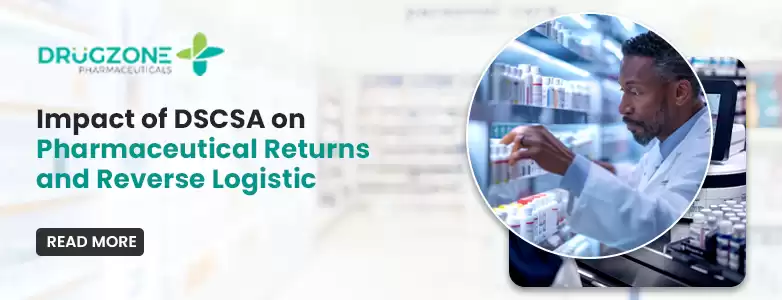
Posted On: June 19, 2024
Key Takeaways for DSCSA 2024 Compliance
Drug Supply Chain Security Act (DSCSA) is a crucial legislation geared at improving the security within the pharmaceutical supply chain. By 2024, every entity along the U.S. pharmaceutical supply chain, including pharmacy wholesale suppliers will have to adhere to DSCSA requirements. Consider these key takeaways that can help ensure your organization is prepared for it.
1. Enhanced Product Tracing
Enhanced product tracing is one of the primary requirements of DSCSA. By 2024, each party in a supply chain must be capable of furnishing comprehensive information about the medicinal products they handle and this includes:
• Transaction Information (TI): Product details with respect to its movement through the drug distribution channel.
• Transaction History (TH): Evidence of any transaction involving a given product.
• Transaction Statement (TS): A statement supported by evidence regarding compliance with DSCSA regulations.
2. Serialization
Serialization is an important aspect to consider in order to comply with DSCSA. By 2024 all pharmaceutical products must have unique serial numbers at individual package levels hence;
• Verification: Ensuring that the product is genuine and not counterfeit.
• Traceability: Tracking the movement of this product throughout its entire life cycle within a supply chain.
The pharmacy wholesale distributors should ensure accurate management and maintenance of such serial numbers.
3. Verification Requirements
To prevent counterfeit drugs from entering into circulation via legitimate drug channels there must be verification processes put in place. By 2024, players in the drug supply chain will be required to;
• Inquire about Product Identifiers that would assure them prior to accepting prescription medicines.
• Check Suspicious Products: Rapidly respond to any alerts related to possible counterfeits or adulterated products.
• Restrain & Report: The moment it becomes suspicious that any product has been compromised, quarantine it immediately then make sure FDA gets informed within a whole day.
4. Interoperable Systems
For the purpose of making sure information circulates smoothly, DSCSA demands that systems that can be integrated with one another should be developed. These systems will enable secure sharing of transaction information, history and statements across the supply chain. Key features include:
• Data Integrity: Ensuring that information is accurate and tamper-proof.
• Accessibility: Making sure that authorized parties can access the necessary information whenever required.
5. Authorized Trading Partners
As per DSCSA, all transactions involving pharmaceutical products must only involve authorized trading partners. Therefore, all parties are required to:
• Verify Trading Partners: Confirm that their trading partners have been licensed and comply with all regulations.
• Maintain Records: In order to continually abide by them, such verifications have to be followed up with detailed records.
Preparing for DSCSA 2024
Compliance with DSCSA 2024 means more than just satisfying regulatory conditions; it involves guaranteeing safety and integrity in the pharmaceutical supply chain. Below are some steps towards preparedness:
• Conduct a Gap Analysis: Discover where you currently fall short of the requirements set forth by DSCSA.
• Invest in Technology: Putting in place technologies supporting serialization, traceability, and interoperability.
• Train Your Team: Enforcing understanding of DSCSA preconditions within your staffs as well as their linkages to compliance efforts.
• Collaborate with Partners: The goal is to align them with regard to regulatory compliance too starting from leading pharma wholesalers so as to effectuate a risk-free traffic channel.
Through these measures pharmacy wholesale distributors together with other members of the pharmaceutical supply chain community will ensure they are well-equipped for DSCSA 2024. Not only will this assist in meeting the requirements but also step up safety measures while promoting efficiency in drug distribution channels on an overall basis.
FAQS
Q1: What are the Main Requirements for DSCSA 2024 Compliance?
Serialisation: each package of prescription drugs requires a unique product identifier.
Traceability: it is required that companies be able to trace the full history of a product's movement through the supply chain.
Verification: before further distribution, participants have to verify the genuineness of product identifiers.
Reporting: The FDA and other relevant authorities must receive prompt reports on any suspect or counterfeit products found within the market.
Q2. What are the Penalties for Non-Compliance?
Not abiding by these rules may lead to stiff penalties that include hefty fines, suspension from operations and litigation. It’s not only a legal obligation but also a business necessity in order to maintain integrity and credibility in the pharmaceutical industry.
Tags
Latest Posts
-

The Impact of DSCSA on Pharmaceutical Returns and Reverse Logistics
-

Understanding the Difference Between Authorized and Unauthorized Pharmacy Distributors
-

DSCSA and GS1: How These Regulations Are Transforming Pharmaceutical Distribution
-

A Beginner's Guide to GS1 Standards for Pharmaceutical Companies
-

What are Important Accomplishments of the NDRP Modernization
Similar Posts
-

The Impact of DSCSA on Pharmaceutical Returns and Reverse Logistics
-

DSCSA and GS1: How These Regulations Are Transforming Pharmaceutical Distribution
-

A Beginner's Guide to GS1 Standards for Pharmaceutical Companies
-

What are Important Accomplishments of the NDRP Modernization
-

New Drugs Regulatory Program Modernization: Overview and Impact
